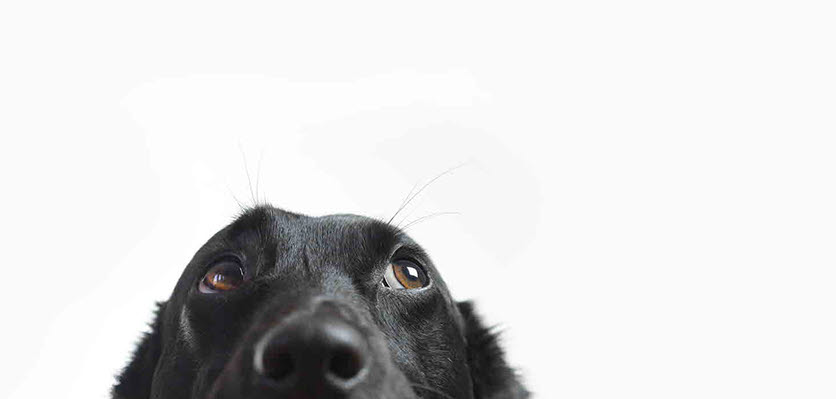
Animals’ facial expressions were once considered exclusively involuntary, reflecting an animal’s emotional reaction rather than an active means of communication. But as we learn more about the complexities of animal behaviour, it is becoming apparent that animals have more control over their facial expressions than we first thought.
Prime examples of active facial expressions in animals come from several studies of facial expressions in apes, showing that they are more expressive in the presence of an ‘audience’, for example when playing with or facing other individuals. This is called the ‘audience effect’ and suggests that these primates may be aware that their facial expressions can be seen by others.1
Dogs are attuned to human attention, especially when human eye contact is involved, with numerous studies demonstrating the importance of eye contact in human-canine interactions. For instance, dogs respond better to non-verbal communication when a human’s eyes are visible, are significantly more likely to ‘steal’ food they’ve been explicitly told not to eat when human eyes are closed and are able to follow the human gaze but only after eye contact has been established prior to gaze shift.1
By the same token, humans are attuned to dogs’ facial expressions, in particular, the raising of the inner eyebrows, a movement that increases the size of the eyes relative to the face, mimicking paedomorphism – juvenile features in an adult. This expression has been shown to increase the perceived cuteness of dogs and, much like with human babies, invokes a maternal/ paternal response in humans. This phenomenon has been demonstrated in shelters, where dogs that performed the inner eyebrow raise were more frequently rehomed in a shorter period of time.2
So, are dogs’ facial expressions merely reactive or do our canine companions experience an audience effect in response to human attention? A recent study posing this very question suggests that dogs are sensitive to human attention and can use their facial expressions as an active form of communication.1
In the study, 24 family dogs were presented with social and non- social stimuli. The dogs were offered food (non-social stimuli), human attention (social stimuli), a combination of both or neither and their facial movements and behaviour were measured in each scenario. Food as a non-social stimulus was chosen based on a previous study showing that dogs are more aroused by food than human attention, but only if the human remains silent.3
The authors hypothesised that if dogs’ facial expressions are only reactive, they would not discriminate between social and non-social stimuli and there would be no difference in facial expressions between dogs being offered food or human attention. Alternatively, if dogs are tailoring their facial expressions based on human attention, the researchers would expect to see differences in the facial expressions of dogs under the different scenarios.1
The authors report that there was a significant effect of human attention on the number and frequency of the dogs’ facial expressions, with dogs performing a greater number of expressions and at a greater frequency when they had the humans’ attention, regardless of whether or not they were receiving food. The facial expression showing the greatest effects were the inner eyebrow lift and the tongue show. What’s more, the visibility of food did not have any effect on dogs’ facial expressions.
The results of this study suggest that dogs were producing their facial expressions based on human attention and not in response to arousing non-social food stimuli (i.e. the food). These findings have implications for the evolution of the human-canine relationship, with the authors suggesting that producing facial expressions in response to human eye contact, especially ones that elicit a physiological response in humans, can be beneficial to the dog. From an evolutionary perspective, active communication through facial expressions may have been an important driver in the domestication of the dog.
References
- Kaminski J, Hynds J, Morris P et al. Human attention affects facial expressions in domestic dogs. Sci Rep 2018;7:12914.
- Waller BM, Peirce K, Caeiro CC et al. Paedomorphic facial expressions give dogs a selective advantage. PLoS One 2013;8:e82686.
- Travain T, Colombo ES, Grandi LC et al. How good is this food? A study on dogs' emotional responses to a potentially pleasant event using infrared thermography. Physiol Behav 2016;15:80–87.
This article appeared in the December 2017 issue of the Australian Veterinary Journal
